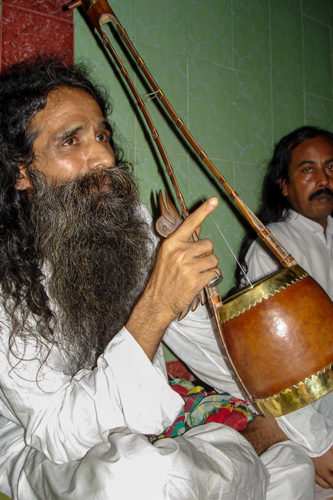Sayeem Rana
Assistant Professor, Department of Music, University of Dhaka
How far the objective of the Baul philosophy of secularism or religious tolerance can motivate a people calls for some investigation. Yet, in Bangladesh and in states similarly multicultural and free of racial prejudice, this has achieved unbelievable success. Here, adherence to coded instructions, manners, tradition, and action bears more significance for the people than their personal sense of values. The Baul followers, by moving away from that mindset, placed more emphasis on humanism and religious harmony and created a system where people, irrespective of race, sect, education, and socioeconomic status, get imbued with the same devotional spirit, sitting in the same platform.

Humaun Shadhu (died 2017) singing while playing ektara, 2013 © Sayeem Rana
The Bauls feel that their ideologies go against the coded doctrines, being more pristine than Veda, being the religion of humanity. They believe in the principle, ‘What you possess within yourself is what exists in the universe.’ Though the Baul ideology flourished in the seventeenth century, it has connections with the Buddhism, Nathpantha traditions. Additionally, there are distinctive influences of Sahajiya, Vaishnavism, Sufism, even in the most secret tantric concepts of yoga, Vajrayana, and Mahayana. Through all this, the Baul proponents, in striving for truth and humanism, have accepted egalitarianism as the key feature. Their anti-Veda thoughts came at the end of the Pal dynasty when the Sen ruler carried out the persecution and expulsion of Buddhists to re-establish Hinduism. To assert this opposition, they renamed the Buddhist concepts of Shunyata, Bodhichitta, Nirvana, and Proggya-Upaya by using terms like Mahabhaba, Paramananda, Jyante-Mora, and Radha-Krishna. In this way, they survived by changing the perspective of ancient Bengali religion. In recognition of this particular aspect, in 2005, UNESCO listed these on the Proclamation of Masterpieces of the Oral and Intangible Heritage of Humanity.
The younger generation, artists, and liberal minds in the upper class who desire to break away from religious orthodoxy to merge with the universal humanity, adore the Baul philosophy. Lalon Sain was the most prominent documenter of the Baul philosophy. People from all walks of life assemble in his akhra (shrine) twice a year in joyous celebration. One is 17 October, the day he breathed his last, and the other synchronizes with the last full moon of the Bengali year, ending in the month known as Dol Purnima. On both the occasions, some hundred thousand people from home and abroad gather to pay respect to him.
The real Baul has no intention of displaying his musical talent or presenting any musical extravaganza. Rather he represents his own inner feeling through his beats and tempos. Without a strong placement of the two features—rhythm and beat—a Baul song cannot achieve its full glory, and for experiencing that glorious incarnation, there is no alternative to watching the live performances in the akhra. The presentations have greater appeal more in casual, homely setups than on a wider stage. There, the Bauls sing spontaneous, heart-felt songs, engrossed in their own body-discipline, unconcerned about the expectations of their audience.
Since the Bauls are not commercial or popular artists, their voices are rather raw and coppery. That is in sync with their lifestyle, which lacks homeliness and the general idea of happiness. They don’t have vocal practice for tonal development or the practice of tunes for evoking specific feelings. Sometimes we see modern artists adopting such raw and brittle vocal effects in their songs though they hardly achieve the natural movement and spontaneity of the Bauls. This is because of the happiness of the spirit, which pours out so freely through an uneven, rough body organ, presenting its complete self.
One special aspect of Baul songs are their tendency to simulate or copy. Some of Bauls, having learned the songs from the guru, re-arrange the messages freely, which the teacher, far from considering plagiarism, edits and accepts. That is why, ad-libbing (bhanita) is important when identifying a composer. Since the songs are mostly descriptive, the tunes are closer to the style of recitation, though, in case of questioning verses, the high and low cadence and jumps at rising notes are noticeable features. This tendency is a specific element of Baul song. When it comes to beat, sometimes they change it towards the end of a song. For example, in some cases, the ending shifts from triple time to quadruple or vice versa. Besides this, the use of alaap and the use of ragas in the pure form in the beginning are the other distinctive features of this form.
In conclusion I would say that extensive research has been done on the Bauls, allowing them international exposure and the prestigious status of an international heritage. What is lacking is an adequate explanation and exploration of the tunes and the right steps for their preservation, which deserve the highest priority when it comes to conserving the Baul philosophy and music.







